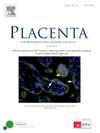Radiomics analysis of placental MRI for prenatal prediction of placenta accreta spectrum in pregnant women in the third trimester: A retrospective study of 594 patients
IF 3
2区 医学
Q2 DEVELOPMENTAL BIOLOGY
引用次数: 0
Abstract
Objective
To develop and validate a model based on placental MRI for the prenatal prediction of placenta accreta spectrum (PAS) in pregnant women in the third trimester.
Materials and methods
A total of 594 pregnant women who were suspected of having PAS and underwent placental MRI antenatally were included and were allocated into the training cohort and testing cohort at a 2:1 ratio. MRI diagnosis was determined by three experienced radiologists. Radiomic features were extracted from images of T2 weighted imaging for each patient. After a feature selection strategy, a radiomics signature and a clinical-radiomics nomogram combining radiomics score and clinical risk factors were constructed to predict PAS. The performance of each model was evaluated using the area under the receiver operating characteristic curve (AUC), accuracy, sensitivity, specificity, and clinical utility.
Results
MRI diagnosis yielded AUCs of 0.77 and 0.79 for predicting PAS in the training and testing cohorts, respectively. The AUCs of the radiomics signature used to predict PAS in both cohorts were 0.80 and 0.83, respectively. The nomogram accurately predicted PAS in both cohorts (AUC = 0.84 and 0.89), with better results than those of MRI diagnosis and radiomics signature in the training (p = 0.009 and 0.003, respectively) and testing cohorts (p = 0.010 and 0.008, respectively), decision curve analysis confirmed its best clinical utility compared to the other models.
Conclusion
Radiomics analysis based on placental MRI may serve as an effective tool to predict PAS in patients with possible PAS in the third trimester.
胎盘MRI放射组学分析对妊娠晚期孕妇胎盘增生谱的产前预测:594例患者的回顾性研究
目的建立并验证基于胎盘MRI的妊娠晚期胎盘增生谱(PAS)产前预测模型。材料与方法纳入594例产前行胎盘MRI检查的疑似PAS孕妇,按2:1的比例分为训练组和检测组。MRI诊断由三名经验丰富的放射科医生确定。从每位患者的T2加权成像图像中提取放射学特征。经过特征选择策略,构建放射组学特征和结合放射组学评分和临床危险因素的临床放射组学nomogram来预测PAS。使用受试者工作特征曲线下面积(AUC)、准确性、敏感性、特异性和临床实用性来评估每种模型的性能。结果smri诊断预测训练组和测试组PAS的auc分别为0.77和0.79。两个队列中用于预测PAS的放射组学特征auc分别为0.80和0.83。在两个队列中,nomogram准确预测PAS (AUC = 0.84和0.89),其结果优于训练队列(p = 0.009和0.003)和测试队列(p = 0.010和0.008)的MRI诊断和放射组学特征,与其他模型相比,决策曲线分析证实了其最佳的临床效用。结论基于胎盘MRI的放射组学分析可作为预测妊娠晚期可能发生PAS的有效工具。
本文章由计算机程序翻译,如有差异,请以英文原文为准。
求助全文
约1分钟内获得全文
求助全文
来源期刊

Placenta
医学-发育生物学
CiteScore
6.30
自引率
10.50%
发文量
391
审稿时长
78 days
期刊介绍:
Placenta publishes high-quality original articles and invited topical reviews on all aspects of human and animal placentation, and the interactions between the mother, the placenta and fetal development. Topics covered include evolution, development, genetics and epigenetics, stem cells, metabolism, transport, immunology, pathology, pharmacology, cell and molecular biology, and developmental programming. The Editors welcome studies on implantation and the endometrium, comparative placentation, the uterine and umbilical circulations, the relationship between fetal and placental development, clinical aspects of altered placental development or function, the placental membranes, the influence of paternal factors on placental development or function, and the assessment of biomarkers of placental disorders.
 求助内容:
求助内容: 应助结果提醒方式:
应助结果提醒方式:


